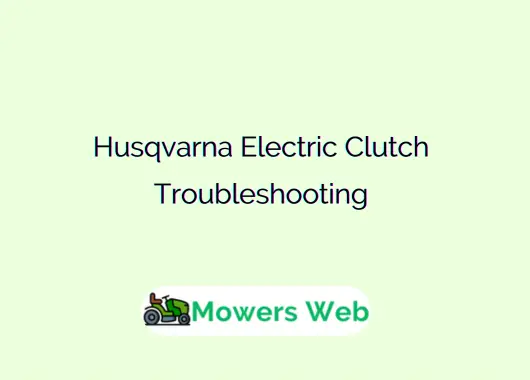This guide explores how the electric clutch works, common problems, step-by-step troubleshooting, maintenance tips, and when to seek professional help, ensuring your Husqvarna mower runs smoothly.
Husqvarna Electric Clutch Troubleshooting
Step-by-Step Troubleshooting Process:
Before starting, prioritize safety: Disconnect the battery, wear gloves, and consult your mower’s manual. You’ll need a multimeter, wrenches, and possibly a 12V charger. Follow these steps:
1. Check Battery and Voltage: Ensure the battery reads at least 12.6V when fully charged. Test voltage at the PTO switch with the ignition on—if below 12V, charge or replace the battery.
2. Inspect Wiring and Connections: Look for corrosion, loose plugs, or chafed wires, especially near the brake or frame. Disconnect the PTO harness and test continuity with a multimeter; coil resistance should be 2–4 ohms.
3. Test the PTO Switch: Bypass the switch using a jumper wire or apply 12V directly to the clutch. If it engages, replace the faulty switch.
4. Examine Safety Interlocks: Verify that the seat, brake, and neutral switches function correctly. A defective seat switch can prevent the seat from engaging or cause the vehicle to stall.
5. Inspect the Clutch Assembly: If needed, remove the deck to check for debris, worn bearings, or brake pads. Measure coil resistance—infinite or very high readings indicate failure. Clean buildup and ensure proper alignment with the crankshaft key.
6. Check for Shorts and Fuses: If fuses blow, disconnect the clutch and turn on the ignition. If the fuse holds, trace shorts in the power or ground wires.
7. Inspect Belt and Pulley: A glazed or worn belt can mimic clutch issues. Check tension and replace if slippery.
If the clutch engages with direct power but not through the system, focus on tracing electrical faults.
Related Why Is My Husqvarna Lawn Mower Surging(6 Causes + Solutions)
Common Electric Clutch Issues
Here are the most frequent problems Husqvarna owners encounter with electric PTO clutches:
- No Engagement: The PTO switch clicks, but the blades don’t spin, often due to insufficient voltage or a faulty solenoid.
- Overheating: Excessive heat can burn out the coil, caused by debris, high belt tension, or prolonged idling.
- Vibrations and Noises: Worn bearings, misaligned pulleys, or uneven belts lead to rattling or clanking, potentially damaging components.
- Blades Won’t Disengage: Worn brake pads or return springs cause blades to keep spinning after the switch is turned off, creating safety hazards.
- Engine Stalling or Fuse Blowing: This occurs when engaging the PTO, often due to wiring shorts, faulty safety switches, or a defective clutch coil.
- Intermittent Operation: High resistance in seat switches or corroded connections can cause sporadic failures.
Some owners report issues like shorts from damaged wiring harnesses, emphasizing the need to inspect cables for wear or chafing.
Related John Deere Electric Clutch Problems(5 Causes + Solutions)
Maintenance Tips for Longevity
Regular maintenance can prevent clutch issues and extend its lifespan:
- Clear debris around the clutch after each use to avoid overheating.
- Grease moving parts as per the manual, using synthetic oils for better protection.
- Avoid idling with the PTO engaged and operate at recommended RPMs.
- Inspect belts and bearings seasonally, replacing worn components promptly.
- Store the mower in a dry environment to prevent corrosion of electrical parts.
For DIY repairs, such as replacing a spring or the entire clutch, use tools like impact wrenches and follow torque specifications to prevent vibrations.
Related Will a Bad PTO Clutch Cause Power Loss?(Explained)
FAQs
How to Tell If an Electric PTO Clutch Is Bad?
Check for no blade engagement, overheating, unusual noises like rattling, or blades that won’t disengage. Use a multimeter to test coil resistance; readings above 4 ohms or infinite suggest a failed clutch.
Why Is My Husqvarna Lawn Mower Clutch Not Engaging?
Common causes include low battery voltage (below 12.6V), a faulty PTO switch, damaged wiring, or a defective clutch coil. Safety interlock issues, like a bad seat switch, may also prevent engagement.
Related How to Remove PTO Clutch Bolt(In 5 Quick Steps)
What Would Cause a PTO to Not Engage?
Low voltage, faulty safety switches (seat, brake, or neutral), wiring shorts, corrosion in connections, or a failed clutch coil can prevent PTO engagement.
What Is Clutch Troubleshooting?
Clutch troubleshooting involves systematically checking the electric PTO system—battery voltage, wiring, PTO switch, safety interlocks, and clutch assembly, to identify and fix issues like non-engagement or stalling.
How Does an Electric Clutch Work on a Lawn Mower?
A 12V electromagnetic coil, activated by the PTO switch, creates a magnetic field that pulls a friction disk against a pulley, transferring engine power to the mower blades.
Why Won’t My Lawn Mower Clutch Engage?
Reasons include insufficient battery power, a defective PTO switch, wiring issues, faulty safety switches, or a worn-out clutch coil preventing proper operation.
Final words
Troubleshooting a Husqvarna electric clutch is manageable with a clear understanding of its operation and systematic checks. By addressing common issues, maintaining the clutch, and knowing when to seek professional help, you can keep your mower in top shape. Regular care ensures reliable performance, letting you maintain a pristine lawn with ease.




